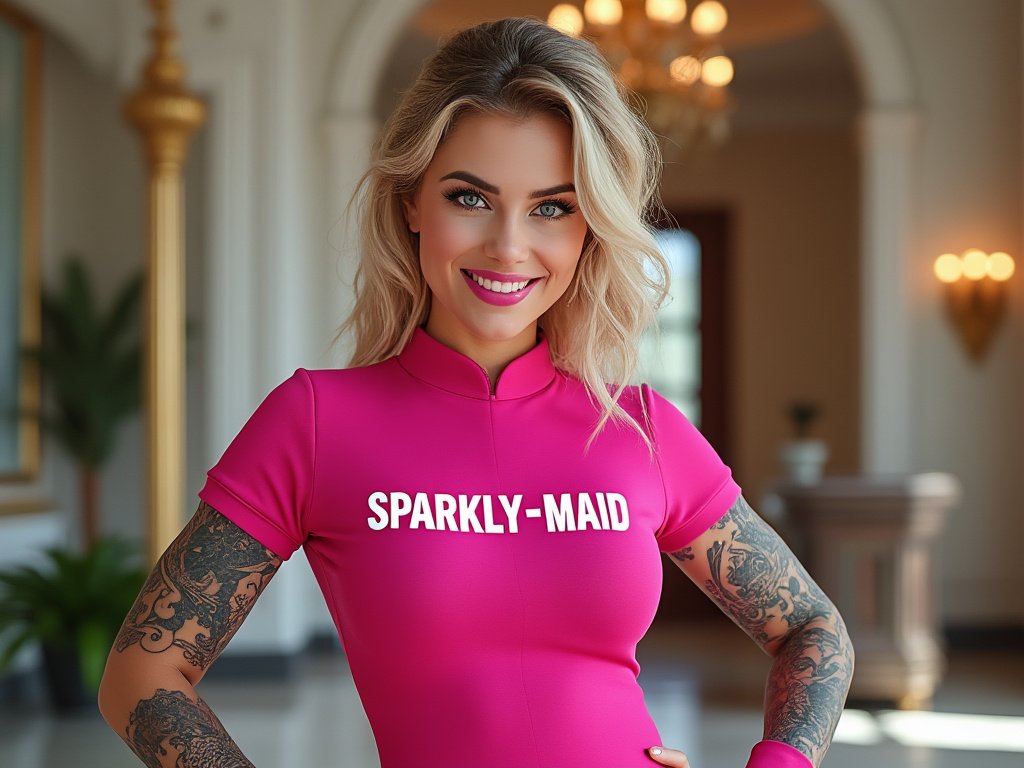Why Are Maid Outfits Sexualized? Unpacking History and Cultural Influences
The Real Deal on Maid Outfits' Sexy Reputation
If you are amongst those who have ever felt that there must be some particular reason as to why the outfit of a maid has been stereotyped as alluring, then you aren't alone. From the humble uniform worn by maids for a long period of time to its use as a form of fantasy and allure in popular culture, it has traversed a long way. Still, what is it about this simple white-and-black maid outfit that conjures images in so many?
Such fascination with maid attire is not a product of modern times; rather, it draws from historical and cultural contexts: from Victorian-era domestics to their proliferation in media and entertainment, the maid outfit has transcended work clothes. As you go deeper into this book, you will realize that changes in social morals, media presentations, and trends in fashion have all combined to make the outfit a source of fascination.
This, per se, can be contextualized within a greater cultural turn that underscores broader themes of power dynamics, gender roles, and societal expectations, hence making it a worthy topic of engagement.
Historical Context of The Sexiest Maid Outfits
The maid costume has evolved from pure functionality to a complex set of meanings that have grown out of cultural shifts and media portrayals.
Origins and Evolution
The Victorian era was the birthplace of the maid costume. As domestic workers, their everyday wear was made for ease of movement and modesty. These uniforms had long dresses, aprons, and caps, indicative of servitude.
Tied to domestic roles, maid uniforms standardized in the 19th century to reflect the servant's position in the hierarchy of the household. When social classes became less rigid, fashion trends had managed to appropriate the aesthetic and give it wider appeal. By the mid-20th century, the maid outfit had become a visual shorthand for service and submission, its design having moved on to more stylized elements present in cosplay and themed events.
Influence of Popular Media
The change in the perception of maid outfits took a different dimension through popular media. Many films, television series, and even manga have often downplayed the less theatrical aspects of their outfits. In fact, in the 20th century, French maid outfits became very famous in film materials that were meant to augment fantasy and romance. This shift often shows the dint of power and romance. Meanwhile, with fusion into character profiles and engaging storylines in anime and video games, the stuff of costuming was crystallized into an image both nostalgic and new. Media depictions strongly refer to stylization over function to hallow its conversion from labor attire to a symbol of fantasy.
Cultural Perspectives Of THe Sexy Maid Outfit
Cultural explanations play an important role in the ways in which maid attires are perceived. There are a number of such perceptions available within different regions, especially when one considers some Western and Eastern points of view.
Western Interpretations
The costume of a maid carries meanings in sexuality and subservience in Western cultures. This perception has its roots in media portrayals where the character of a maid is often depicted within contexts of a sexual nature, often where themes of submission and fantasy are well evident. This imagery is further popularized by Hollywood films and television series that portray maids in very uniform-focused light, as little more than alluring costume pieces rather than functional clothes. There are also influences of Victorianism in Western-costumed maids, where such costumes represent exactly how housekeepers looked during this period. Such a historical lead-in only heightens this concept of maids as subservient figures within a story. In a Western context, the imagery of outfits of maids serves easily to evoke notions of fantasy and desire evoking power dynamics between employers and the characters of maids.
Eastern Interpretations
There are some eastern cultures like in Japan where variations of the sexy maid outfit have become popular representations through anime, manga, and even "maid cafes". These provocative outfits are normally stylized and brought across as cute or "kawail" in nature, showing innocence and charm. The Japanese popular culture, in this way, has adopted the maid outfit as varied representations of fantasy and escape, far removed from their western counterparts. Japanese maid cafés have, in some ways, perpetuated this meaning through their theme of service wherein customers in these cafes are waited upon by young women dressed in makeshift yet elaborate cosplay of maids, dollops of nostalgia and fantasy thrown in for good measure. This modern cultural phenomenon underlines how meanings in Eastern cultures circle around the playful and whimsical aspects of the costume. It is almost ironic that the Eastern perspective would emphasize cuteness over sexuality in those garments, while they remain today a symbol of fantasy and escapism within the popular culture.
Psychological Aspects Of Alluring Maid Outfits
Maid outfits are usually very complex in design and cultural weight, and therefore tend to be symbols of complex psychological themes whose appeal is deeply intertwined with instances of power dynamics and a measure of fantasy that shapes perceptions and emotions.
Appeal of Power Dynamics
Power dynamics always play a part in the attractiveness of the maid costume. Many of the dresses are reflections of a transference of power, and some wearers take on roles that invert or subvert norms. In relationships where dominance and submission are explored, it's maid attire that provides the visual cue for a processed change in control. The origin of the uniform in service roles further cements this dynamic, as the wearer offers themselves to be committed and accessible. Cultural narrative often eroticizes this as an ultimate consensus and understanding of power being exchanged. The combination of the media and personal contact makes the maid outfit represent one level of these dynamics-or, rather, a place where people should exercise and debate these complex themes of authority and subservience.
Role of Fantasy and Fetishization
It is fantasy and fetishization that highly support the sexualization of costumes as maid outfit affairs. Costumes as maid outfits serve as the centerpiece for stories that try to grapple with desires and escapism. Media representations often focus on the seductive appeal of the uniforms, with elements of playful seductiveness. Characterizations in anime and manga often combine innocence with allure, something which is appealing. The fantasy can be much further than just appearance; with role-playing situations, individuals may act out deeper, usually repressed desires. It acts out the ideal of devotion and service, turning humdrum dress into powerful symbols of fantasy fulfillment. The costume enables one to connect a fantasy to reality and enables self-expression by exploring identity.
Impact of Fashion and Marketing
Fashion and marketing have greatly heightened the allure of the sexy maid outfit to the extent that it has nowadays become a role playing and fantasy costume. These features are important in developing perception and hence popularity of this costume.
Incorporation in Popular Fashion
Gone are the days when designers only looked to modern fashion as the basis of their new, high-fashion statements. Ruffles, lace, and aprons-plush characteristics of the basic maid uniform-enter today's collections to ring in a certain longing for nostalgia and fantasy. The brands capitalize on the aesthetic value of such features through catwalks and seasonal presentations. All these combinations of functionality and drama call customers to immerse themselves in fantasy themes while wearing the latest fashion. To this count, the fusion of retro elements with modern trends keeps alive the charm and mysteriousness surrounding the outfit of a maid.
Marketing Strategies and Trends
Sexualization of the maid outfit is more noticeably reinvigorated by strategic imagery and narratives employed in marketing. Advertisers often put such a costume into sensual contexts and emphasize themes of submission and allure. The web campaigns include fantastic plots that allow consumers to fulfill their wishes of escaping reality easily. Such pictures run rampant across online platforms, social media, and influencer partnerships, reaching great swaths of people in minimal time. Furthermore, targeted campaigns address special segments, such as cosplay and themed events, which maintain the popularity of maid outfits on a cultural level. The strategic application of romanticised imagery and stories carries out the inscrutability and intrigue surrounding these pieces of clothing, therefore turning curiosity into demand.
Criticisms and Controversies
Outfits of maids or maid costumes are debated and receive lots of criticism because of sexualization, among other manners of representation in media. These discussions allow analysis of implications and societal impacts of such depictions.
Feminist Perspectives
Indeed, feminist critiques have pointedly pointed out the issue of maid outfits reinforcing gender stereotypes and objectification. Sexist outfits relate to the symbolic representation of subservience and foster the idea that such is the role of women: subservient and submissive. Sexualization associated with such outfits tends to reduce the apparent degree of autonomy and agency of women to ornamentation in narratives, according to feminist theorists. The result is that, within social life, such stereotypes are being reinforced and this may result in the reinforcement of obsolete gender roles. More than that, from a feminist perspective, such representations should be disputed and opened to other forms of representations that would treat women with respect in regards to their autonomy, rather than reducing them to mere symbols of desire or submission.
Social and Ethical Implications
Sexualization of maid costumes raises a number of serious social and ethical questions about power and consent. These garments are most often used to represent scenes of relationships where a person with unequal power is subordinated. Such characterizations may blur lines on consent to fantasy representations and impact how people understand the boundaries of acceptable behavior, perhaps normalizing relationship imbalance. Ethical discourse centers on the responsibility that should be exercised by the media and the industries of fashion in their creation and proliferation of such images and storylines. This means critically examining and taking into consideration how those depictions might negatively contribute to society in general-for example, by influencing real-life attitudes toward issues related to gender and consent. Hosting such discussions allows reflection on the narrative in culture that it promotes and how those cultural stories align with evolving social values.
Wrapping Up: The Maid Outfit's Hot Take
The historical, cultural, and psychological perspectives can all give a multifunctional understanding of the sexualization of the maid outfit. They have evolved from practical garments to creating fantasy roles due to the control of society and media. While they can signify themes related to power dynamics and escapism, debates related to gender roles and objectification arise. But while contemplating the appeal of the maid outfit, reflect on the broader general cultural narratives and what those have allowed for in the way of identity and self-expression. Approaching the topics with a little more thoughtfulness, you can appreciate just how intricately layered a reason there can be for fascination with maid attire.
Frequently Asked Questions
Where did the history of the maid outfit come from?
The use of maid outfits as serviceable working attire amongst household workers started in the Victorian era. They were modest and practical but stood emblematic of the servitude in household hierarchies. Maids carry both cultural and symbolic significance and are implicitly remade through popular media portrayals.
How have uniforms for maids evolved in popular culture?
What started off as a utilitarian outfit has slowly moved into the realms of fantasy and nostalgia. The media, especially-things like film and television and manga-have made this outfit theatrical and romantic, stylizing it into a symbol far removed from its original function.
How does the understanding of the maid outfit differ in Western and Eastern cultures?
The image of a woman in a maid's outfit conveys sexuality and subservience in the West due to the high level of attention and depiction of subordination in movies, television serials, and books. Eastern culture, particularly that of Japan, has also espoused the maid costume through anime, manga, and maid cafes, wherein maids are seen as quite cute and charming, touching the heart but never the sense of sexuality; more innocence and escapism.
What role do the outfits of maids have in the power balance and fantasy?
A maid's dress can be used to denote power struggles through the inversion of traditional hierarchies into discussions of mastery and subjugation. They are a visual shorthand for stories of self-denial and availability, fusing innocence and allure in a way that enables a delving into fantasy and self-identity.
How does fashion influence the desirability of a maid outfit?
Fashion was able to make even the most ordinary outfits of a maid an object of fantasy; to reinterpret the ruffles and lace, traditional elements of today's design. The fashion designers resurrect nostalgic spirit, while marketing strategies apply sensual contexts and fantasy-driven scenarios to capture consumers' desires for escapism.
What are some of the criticisms associated with a sexy maid outfit?
There are criticisms that link sexualization through media and objectification to enforcing gender stereotypes. The feminist views indicate that the outfit denotes servitude, and the discussions highlight the need for development in both media and fashion industries.
Why does the modern maid costume equate to fantasy and escape?
The idea of a maid costume has become a source of fantasy for some, an act of fleeing from reality, partly because such images through media and fashion have been stylized to represent innocence, nostalgia, and even allure. They allow one to express deeper desires through various means of role-playing and thus combine fantasy with self-expression.




